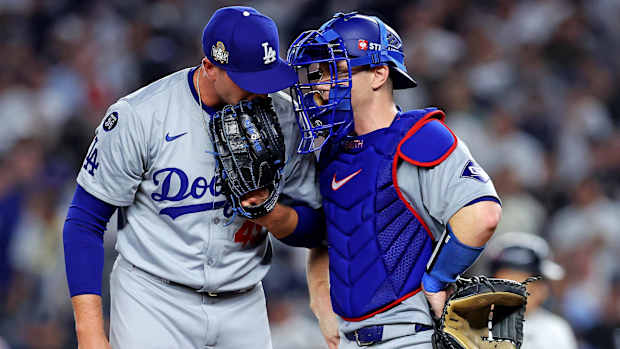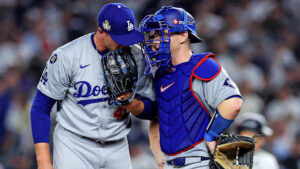
 Six Lessons to learn from the Dodgers’ World Series win…
Six Lessons to learn from the Dodgers’ World Series win…
Every year for 24 consecutive years the World Series has given us a new champion. Repeating is difficult because of the expanded postseason, a more even distribution of talent and the democracy of analytics and technology, which can level the playing field in non-monetary ways. The bottom line is there are many ways to win a World Series-from a sixth seed last year (Texas Rangers) to a one seed this year (Los Angeles Dodgers). But there are some lessons we can learn from the 2024 World Series. For instance, the next World Series champion is likely to have elite power. The past five champions all have ranked in the top four in MLB in home runs. As hits have grown scarcer, the home run ball looms larger in deciding games.
Here is what else we learned from the 2024 World Series: 1. Spin is in The Dodgers threw 41.2% breaking pitches against the Yankees. Since pitch tracking began in 2008, that’s the heaviest dose of spin by any of the 34 World Series teams.
Los Angeles knew the New York offense was predicated on taking pitches and creating count leverage to force pitchers into the zone with fastballs-and hammering them. The Dodgers did not let that happen.
Los Angeles kept the Yankees off balance by throwing the abundance of breaking pitches. The idea was to constantly change speeds to keep hitters uncomfortable. There was no better example than how Yoshinobu Yamamoto and Blake Treinen carved up Aaron Judge in Game 2 (0-for-4, including three strikeouts). Judge saw 21 pitches in Game 2. He saw the same pitch a second time in a row in the same at-bat only twice-and whiffed both times. Look how Yamamoto and Treinen yo-yoed Judge with pitches as far apart as 21 mph: The Dodgers expertly executed this back-and-forth style of pitching throughout the series. The Yankees were the No. 1 slugging team against fastballs in the regular season. They had an easy time with the Royals and Guardians in the first two rounds because those teams inexplicably threw them less spin than the Yankees saw in the regular season.
The Dodgers gave the Yankees a whole different look. They threw so much spin that when they did attack with fastballs the Yankees were not on time. This progression of pitching plans against New York says it all: the way to get the Yankees off the fastball was with increased spin: 2. The Dodgers took Juan Soto off the board. Before Game 1, Dodgers manager Dave Roberts was asked which hitters in the Yankees lineup most concerned him.
“Soto,” Roberts said. Then, looking over the New York lineup card, added, “Soto, Soto, Soto.” Soto is the best fastball hitter on the planet. Overall in the postseason Soto hit .600 and slugged 1.300 against fastballs. The Dodgers’ plan for Soto was brutal in its simplicity: never give him a fastball to hit in any meaningful spot. The pennant-winning home run Soto hit off a four-seamer from Hunter Gaddis of Cleveland, one of the most ridiculous pitch calls in recent memory, was fresh in their minds.
Los Angeles preferred pitching to Judge. The plan worked perfectly until Jack Flaherty threw Judge a first-pitch fastball right down Broadway in Game 5. Yankees manager Aaron Boone accommodated the Dodgers’ plan to take Soto off the board by never tweaking his lineup. He was fully committed to Gleyber Torres-Soto-Judge as the 1-2-3 hitters, a combo that worked well down the stretch. But when Torres and Judge went cold, the lineup remained the same.
Boone could have batted Judge first, with Soto behind him. The Dodgers did that with Shohei Ohtani and the Mets with Francisco Lindor. The idea is to have the whole lineup protect your best hitter, get that hitter to the plate as often as possible and, in the case of Judge just as it was for Lindor, take pressure off a cold hitter by asking him to simply get on base, not produce damage. Boone said he did think about batting Judge leadoff for Game 4, but opted against it because he did not think it was fair to Torres. But Torres had gone cold. He took the most plate appearances for the Yankees in the series and slashed .143/.250/.333. With Torres cold and the Dodgers flipping Soto so much spin out of the zone, Soto became a non-factor. He saw four pitches the entire series with a runner in scoring position, including one pitch in the zone. He saw just 10 pitches in the zone with a runner on base.
Years from now people will look at the statistical summary of the 2024 World Series and ask, “How did the Yankees not win?” New York had more hits, more home runs, more walks, more stolen bases, a higher batting average, a better on-base percentage, a lower ERA and a lower WHIP. To understand why the Yankees lost you had to watch the games. Their fifth-inning collapse in Game 5 was historically awful. But at every turn the Dodgers made plays the Yankees did not. Here are some of the key hidden moments why Los Angeles won the series: The 10th-inning walk in Game 1 by Gavin Lux.
The Yankees were two outs away from winning Game 1, 4–3. Jake Cousins, facing the 7-8-9 hitters, had just retired Will Smith. Lux was hitless in his last 16 plate appearances. Cousins walked him on five pitches, four of which were nowhere close to the strike zone, including a wild high sinker after four straight sliders. The walk virtually assured the lineup would turn over, and when it did, Boone called on Nestor Cortes, who gave up the grand slam to Freddie Freeman. Tommy Edman’s trip around the bases in Game 3. Batting ninth, Edman drew a four-pitch walk from Clarke Schmidt leading off the third. (Yankees pitchers had some terrible walks, and the Dodgers made them pay.) Edman took off for second on his own on a 2-and-2 pitch, allowing him to reach second and stay out of a double play as Ohtani grounded out. He scored on a bloop single because he broke immediately on a perfect read rather than hesitating to see if the ball could be caught.
Kiké Hernández’s baserunning in Game 5. With runners at first and second in the fifth, Smith hit a ground ball to the right of Yankees shortstop Anthony Volpe. Running from second, Hernández bowed his angle to disrupt Volpe’s throwing lane (perfectly legal). Volpe, sidearm, alligator-armed his throw into the dirt and Hernández’s running lane. Third baseman Jazz Chisholm should have been able to secure the ball on a short hop. But he did not work his glove hand through the ball and dropped it. The three at-bats against Tommy Kahnle in Game 5.
Read more at: https://www.macon.com/sports/article294993724.html#storylink=cpy
Leave a Reply